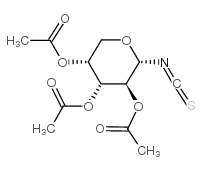Induction of quinone reductase by allylisothiocyanate (AITC) and the N-acetylcysteine conjugate of AITC in Hepa1c1c7 mouse hepatoma cells.
Eun-Sun Hwang, Hyong Joo Lee
文献索引:Biofactors 26(1) , 7-15, (2006)
全文:HTML全文
摘要
Cruciferous vegetables contain a series of relatively unique secondary metabolites of amino acids, called glucosinolates, from which isothiocyanates (ITC) can be generated. While glucosinolates are not thought to be bioactive directly, ITC appear to have anticarcinogenic activity. Sinigrin, the predominant aliphatic glucosinolate in cruciferous vegetables, is hydrolyzed to yield allylisothiocyanate (AITC), which, following absorption and metabolism in humans, is excreted in the urine as an N-acetyl-cysteine (NAC) conjugate. AITC possesses numerous biochemical and physiological activities. This study examined the induction of quinine reductase (QR) by AITC and synthetic AITC-NAC in Hepa1c1c7 murine hepatoma cells. AITC and AITC-NAC inhibited cell growth in a dose-dependent manner. The induction of QR activity and QR mRNA expression was dose-responsive over a range of 0.1-2.5 microM. AITC caused 2.0- and 3.1-fold inductions of QR with 1- and 2-microM treatments, respectively. By comparison, 1 and 2 microM AITC-NAC caused 2.9- and 3.7-fold inductions of QR, respectively. Considering the potential of ITC to prevent cancer, these results provide a basis for the use of NAC-ITC conjugates as chemopreventive agents.
相关化合物
| 结构式 | 名称/CAS号 | 分子式 | 全部文献 |
|---|---|---|---|
 |
2,3,4-三-邻-乙酰基-Α-D-吡喃阿拉伯糖异硫氰酸酯
CAS:62414-75-9 |
C12H15NO7S |
|
Neural peptidase endothelin-converting enzyme 1 regulates en...
2014-06-01 [J. Clin. Invest. 124(6) , 2683-95, (2014)] |
|
Transient receptor potential ankyrin 1 receptor activation i...
2014-01-01 [PLoS ONE 9(5) , e97005, (2014)] |
|
Corneal sensory nerve activity in an experimental model of U...
2014-06-01 [Invest. Ophthalmol. Vis. Sci. 55(6) , 3403-12, (2014)] |
|
Transient receptor potential ankyrin-1 (TRPA1) modulates sto...
2013-12-01 [Biochim. Biophys. Acta 1833(12) , 3025-34, (2013)] |
|
Effects of acid on vagal nociceptive afferent subtypes in gu...
2014-08-15 [Am. J. Physiol. Gastrointest. Liver Physiol. 307(4) , G471-8, (2014)] |